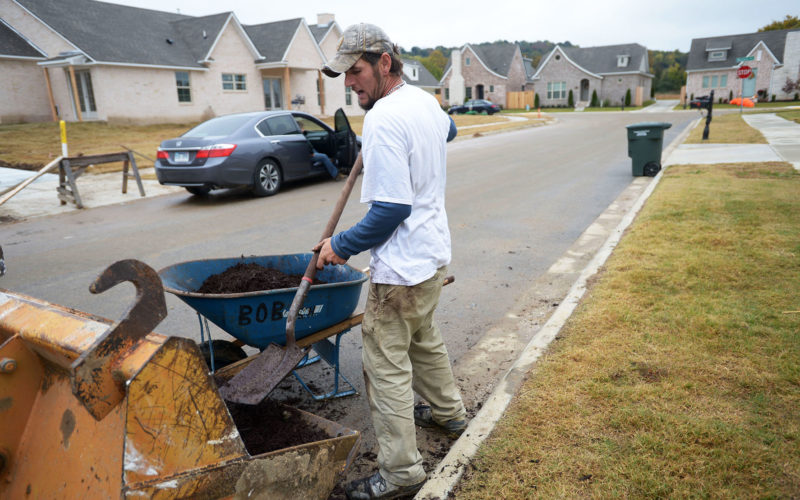Design standards for subdivisions spark discussions
STACY RYBURN
sryburn@nwadg.com
Fayetteville planning commissioners say denser subdivisions will be better off with additional design standards, while developers worry the city will overstep its reach and contribute to the increasing cost of doing business.
A proposal on subdivision design standards grabbed the attention of members of the development community during a Planning Commission meeting last week. Ten people spoke, mainly builders or their lawyers, citing concerns with the suggested regulations.

NWA Democrat-Gazette/ANDY SHUPE
Aaron Wirth, builder with Cobblestone Homes, walks along a shared driveway Thursday, Oct. 25, 2018, behind a row of houses a subdivision being constructed south of Mountain Ranch in Fayetteville. The Brooklands subdivision will be built over multiple phases spanning several years. Phase I is under way with about 80 homes being built. Cobblestone Homes is the builder on the project.
Commissioners ended up tabling the item until the first meeting in December. In the meantime, focus group workshops will be held with members of the development community, commission and planning staff. The Fayetteville City Council will have the final say on any code changes.
The commission formed its approach based on new subdivisions being built at a higher density than in the past. The most common zoning designation for a subdivision for decades has been four single-family homes per acre, commissioners assert. Today, more and more developers are building within zonings of eight to 10 or more units an acre, partly because of the city’s vision encouraging infill development.
The city’s design standards haven’t been adjusted to accommodate the denser pattern of development. The commission’s proposal attempts to tackle issues that could spring up because of that, on the basis of promoting safety and quality of new neighborhoods, according to a commissioner.
Developers express concern more requirements will equate to a higher cost to build, which would get passed on to homebuyers. Some own wide swaths of land, for example, and changing the rules midstream could potentially force costly revisions. Many of the design templates developers use as a cost-saving measure could become obsolete, they say.
What’s on the table?
Planning Commission Chairman Matt Hoffman, an architect, said city leaders have seen a steady stream of residents come to City Hall with concerns about rezoning for denser development. Compatibility frequently comes up. Commissioners hope to encourage developers to build neighborhoods that are compatible with the kind of places people think of when they think of Fayetteville, he said.
Hoffman used the Rolling Hills, Wilson Park and Washington-Willow neighborhoods as examples. Each of those places is unique with different qualities that attract people to them, he said.
The standards would apply to zonings higher than a single-family district up to four units per acre. However, they wouldn’t necessarily encourage high-density development, Hoffman said. Rather, if developers choose to build at a higher density, then the framework would kick in, depending on the project.
“You couldn’t say, ‘OK, what we’re going to get if they pass this ordinance is a bunch of two-story houses with alleys built on small lots.’ That’s not what this is,” he said. “What this is saying is how do we make some of the places in Fayetteville that are known to be nicer places — how do we make those the standard of development?”
For example, the average length of a home facing the street in the city has decreased from 70 feet to 50 feet, according to the proposal. However, dimensions for a two-car garage have stayed the same. Also, sometimes a garage protrudes from the front entrance of a home, an idea which some design professionals refer to as a snout house.
The effects can combine to make the average neighborhood street look more like a self-storage facility, the proposal states.
Commissioners cite the defensible space theory that architect and planner Oscar Newman developed in the early 1970s. The idea is that streets are safer when residents can see them clearly from inside, and homes designed with a protruding garage door and spare bedroom facing the street discourage neighborhood surveillance.
The proposal has a number of suggested standards with certain exceptions. No more than 25 percent of a home’s street frontage would be taken up by a garage door. However, a quarter of homes in a new development would be exempt from that requirement. Garages would be set back farther than or in line with the front door. Kitchens, living rooms and windows should face public streets. The width of a typical suburban street would be reduced from 28 feet curb-to-curb to 20 feet.
Blocks within the subdivision would include 12-foot-wide paper alleys that would provide access to all lots. A paper alley refers to a throughway that appears on a planning map but isn’t necessarily built out. The idea is to leave enough room for access to an accessory dwelling unit, should the homeowner decide to build one, according to the proposal.
The cost
Josh Carson, general counsel for Rausch Coleman Homes, said when planning commissions and municipalities start trying to regulate aesthetics and architecture, builders start to worry those bodies are regulating beyond their scope and costs will go up.
“Every suggestion that is made, while there may be some good intent behind it, means more money,” he said. “It means affordability is dwindling.”
The marketplace — what buyers want — should determine what works and what doesn’t work in design, Carson said.
The average price of a house in Washington County is $235,618, up 12 percent from last year, according to the latest Skyline report from the Center for Business and Economic Research at the University of Arkansas. Continued population growth, paired with finite residential lot space, have pushed real-estate prices to record levels, the report states.
The average price in Benton County is slightly higher at $238,098, a 5 percent increase from last year.
The increase is even more dramatic when considering the past five years. Average home price in Washington County was $173,979 in 2013. Benton County averaged $185,500 that same year. That means Washington County experienced a 35 percent increase and Benton County a 28 percent increase over five years.
Labor, material costs and the shrinking supply of available lots has contributed to the rising prices, the report states. To make up the costs, developers will try to rezone to build more, smaller homes or build fewer, bigger, more expensive homes, said Mervin Jebaraj, the center’s director.
Fayetteville has 62 active subdivisions, meaning some degree of building is happening. About 30 more have gained approval from the city but haven’t started building yet, according to the center’s figures.
Across Northwest Arkansas, there are 374 active subdivisions being built with more than 26,600 lots. So far, it seems the region hasn’t experienced a slowdown of building, Jebaraj said.
Builders work hard to meet a city’s standards and codes as efficiently as possible, Carson said. Changing aesthetics oftentimes doesn’t take into account the economics, he said.
“We’ll build you anything you want,” Carson said. “If you want to pay us $1 million, we’ll build you a $1 million house. But it’s the buyers that dictate that. And they will buy and build what they’re proud of and what they can afford. But when you start adding requirements to that, it starts pricing people out of homes.”
So far this year in Northwest Arkansas, the least expensive single-family home was built in Rogers for $60,000. The most expensive was in Fayetteville for $1.5 million, according to city building reports. These are the anticipated sales prices.
Working together
The city already has a number of design standards on the books, Planning Director Andrew Garner said. They range in intensity — downtown design standards, for example, regulate everything from the thickness of window sills to door placement, he said.
Historically, city leaders have had little political will to keep adding design standards for single-family homes, Garner said.
Commissioner Rob Sharp, also an architect, said he’s glad to see builders and developers get involved with the coming workshops. Building on smaller lots can have unintended consequences, and commissioners have the best interests of residents in mind, he said.
“The people who are looking for homes really don’t have a seat at the table yet,” Sharp said. “We want to make sure when they are in the market and looking for a house, that there are some options out there — something besides just the most common housing type.”
Aaron Wirth, a builder with Cobblestone Homes, also welcomed working in the focus-group sessions. He said the city and developers generally have a good relationship, but there can be challenges.
“It’s no fun when you’re midstream on a project and the rules change and you don’t know what you’re doing,” he said. “That’s terribly frustrating as a developer or builder. Especially if you didn’t know they were coming down the pipe.”
Springdale standards
Several developers and their representatives, local and national, packed Springdale’s administration building during a Planning Commission workshop Thursday. Commissioners and planning staff proposed standards for single-family homes in subdivisions with at least 20 lots. An initial draft suggested standards ranging from decorative detailing on a front door to vegetation in front yards other than grass. A provision to prohibit vinyl, wood and aluminum siding, among other material, particularly drew the ire of builders.
Mayor Doug Sprouse said the draft was meant as a starting point. The idea from the beginning was to get input to help ensure protections for the investments people are making in Springdale, he said. There is no deadline for a final proposal. “I would say we’re very early in this process,” Sprouse said.






